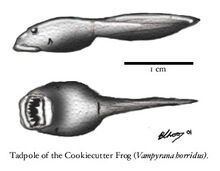INTRODUCTION
What with the distractions posed by larger and more flamboyant creatures, the amphibians, oldest of the tetrapods, have been sadly neglected in our studies.
CRYPTOBRANCHIDAE (Hell-benders and crocmanders)
AMPHIBISUCHIA (Crocmanders)
On first inspection, the crocamanders seem to be a surviving lineage of giant temnospondyls, an archaic amphibian lineage that by all regards died out in the Early Cretaceous of Australia. But looks can be deceiving.
From their scanty fossil record, it seems that at some point in the Miocene a group of cryptobranchid salamanders, related to the RL's hellbenders and giant salamanders, started to grow larger, developing broader skulls and mouths, and fed on larger prey. With the coming of the Ice Age, the ancestors of the crocamanders soon found their main potential competitors, the crocodilians and mosasaurs, driven south by dropping temperatures, allowing them to evolve into “coldwater crocs”, and North America’s largest aquatic predator for much of the Pleistocene.
However, warming temperatures soon proved disastrous for the crocamanders, as mosasaurs and crocodiles soon spread back over their former range, and the overall environmental change dealt an almost crippling blow.
Today, crocamanders are represented by only 6 species in 2 genera in North America and northern Eurasia.
Great Crocmander (Amphibisuchus champlainensis)
The great crocomander, the largest living species at 10 feet, which seems to be mostly confined to Lake Champlain, with unverified reports from the Great Lakes region.
Allegheny Gator (Amphibisuchus horridus)
The allegheny gator, a large species approaching 7 feet, which has relict populations scattered in cold streams and rivers in the Appalachian and Ozark mountains.
Dwarf Crocmander (Nymphasuchus levis)
These include the dwarf crocomanders, animals not much bigger than RL's hellbenders, common over the great plains region, with a related species in the east.

The three North American Amphibisuchids: Great crocmander (Amphibisuchus champlainensis), Allegheny gator (A. horridus), and Dwarf crocmander (Nymphasuchus levis)
Krokotritona (Amphibisuchus longi)

Krokotritona, Amphibisuchus longi (Northern Eurasia) See The Salmonite Run
The krokotritona is the larger of the two Eurasian amphibisuchids, a monster amphibian that inhabits lakes and deep streams across much of the great continent. Like all crocmanders, krokotritonas grow slowly but continuously through their long lives, with some individuals reaching over half a century in age and three meters in length. At this size, krokotritonas perfectly capable of killing small dinosaurs, which they ambush croc-style from the riverbanks. These crocmanders also eat a variety of smaller aquatic life, from insect larvae to fish to salmonites.
GYMNOPHIONA (Caecilians)
Blueboa (Gangetopeton largus)
The Blueboa (Gangetopeton largus), is a 1.5 meter caecelian, adept at ambushing tiny fish and rodents in the shallows, with a bluish-grey slimy hide, it is striking at the very least, to spy in the mud. This creature is native to the various waterways of south and southeast Asia.
ANURA (Frogs and toads)
Under construction
Bullywug (Dahinda americana)
The bullywug is the Spec-equivalent of a bullfrog. It is a large, massive frog with green or yellow skin, and a tongue that's almost as long as its body, allowing it to catch prey from more than 11 cm away. A bullywug's large mouth and head can fit around just about anything, including fish fry and the larvae of other amphibians.

Cookiecutter-frog (Vampyrana horridus) tadpole
Cookiecutter Frog (Vampyrana horridus)
The tadpole of the cookiecutter frog (a small ectoparasitic amphibian of swamp-dwelling dinosaurs) is a voracious carnivore with a formidable set of jaws that swarm around aquatitans, attacking molluscs, fish and other tadpoles that feed on algae growing on the dinosaur's hide. They also have the disturbing habit of gnawing their way into the cloaca and leaving with a mouthful of flesh.
Understandably, the aquatitans find this behavior alarming, particularly the younger animals. They will often storm out of the water, in doing so stranding dozens of their tiny tormentors in their rectum. This is the cue for the rectal probes which flock around the dinosaur's cloaca, probing with their long bills to extract and eat the wriggling, gnashing tadpoles.

